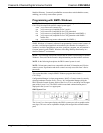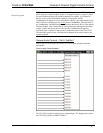
Cresnet 4-Channel Digital Volume Control Crestron C2N-VEQ4
22 • Cresnet 4-Channel Digital Volume Control: C2N-VEQ4 Operations Guide - DOC. 6135A
The C2N-VEQ4 provides twelve filters for each channel, with five modes of audio
equalization (settable using Digital Media Tools):
• A ten-band graphic equalizer and a two-band parametric equalizer. In this
mode, the first ten filters in all channels are used to set up the default
frequencies (31.5Hz, 63Hz, 125Hz, 250Hz, 500Hz, 1KHz, 2KHz, 4KHz,
8KHz, and 16KHz) for graphic equalization, leaving filters 11 and 12
available for parametric equalization.
• A five-band graphic equalizer and a seven-band parametric equalizer. In this
mode, the first five filters in all channels are used to set up the default
frequencies (63Hz, 250Hz, 1KHz, and 4KHz, 10KHz) for graphic
equalization, leaving filters 6 through 12 available for parametric
equalization.
• A speech optimized version of the five-band graphic and seven-band
parametric equalizer arrangement utilizing default frequencies (160Hz,
600Hz, 1KHz, and 2.5KHz, 5KHz)
• A three-band graphic equalizer and a nine-band parametric equalizer. Here
the first three filters in all channels are for the default frequencies (250Hz,
1KHz, and 4KHz), leaving filters 4 through 12 available for parametric
equalization in case you want to notch out a 60 Hz hum or other resonant
frequency.
• A full twelve-band parametric equalizer. You may use the equalizer as a full
twelve-band parametric equalizer, however it is recommended that you first
become fully familiar with equalization techniques.
The <FilterType> inputs set the type of filter or equalization. Valid values are as
follows:
0 = Off (No parametric equalization).
1 = Peaking EQ (Permits precise amplitude adjustment of a selectable range of
frequencies, or removes an unwanted frequency from a signal). The
bandwidth range can vary from a small slice of the spectrum to a 3.5-octave
area. Typically, peaking EQ filters allow fine adjustment to compensate for
room acoustics, noise, and speaker limitations.
2 = High Pass (Filters out all audio below the <FilterFreq> levels). A high-pass
filter circuit passes all signals that have a frequency higher than the specified
frequency, while attenuating all frequencies lower than its specified
frequency.
3 = Low Pass (Filters out all audio above <FilterFreq> levels). A low-pass
filter passes all frequencies below the specified frequency, while attenuating
all frequencies above this specified frequency.
4 = Treble Shelf (Uniformly boosts or attenuates all frequencies above the
<FilterFreq> levels, without affecting the frequencies below. The amount of
modification is given by <FilterGain>). A Treble Shelf filter boosts or
attenuates all frequencies above the specified frequency in a uniform manner
while not affecting the low frequencies below the specified frequency. For
example: Because bass frequencies have longer wavelengths, small speakers
may sound distorted when trying to reproduce these frequencies. The Treble
Shelf filter can increase the proportion of treble to bass, enabling the smaller
speakers to produce a clearer sound.


















